
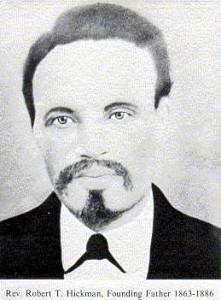
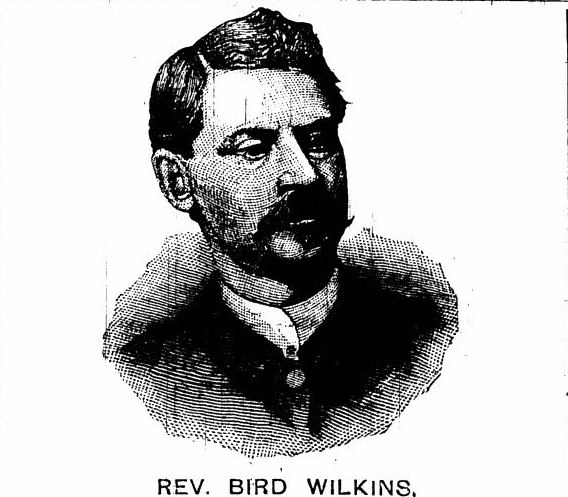


It was also during Rev. McDonald’s pastorate that a controversy arose which divided the church. Early in 1914, Rev. McDonald and up to one-half of the membership left Pilgrim and purchased Memorial Baptist Church. This church was located on Rice Street and had a seating capacity of 600. The present Mt. Olive on Central Avenue is a descendant of that church.
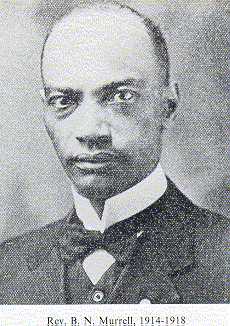
When the St. Paul Ministerial Alliance was formed at Pilgrim in 1916, Rev. Murrell became its first secretary. This organization is the forerunner of the now powerful Ministerial Alliance. During the war, Rev. Murrell served for two years as a member of the American Expeditionary Force with the YMCA. Much of the credit for leading the church while he was away is credited to the stable leadership of Deacon George Wills.

Pilgrim entered a new era of religious awareness under the capable ministry of Dr. Lee Ward Harris. After receiving his Bachelor of Divinity Degree from Emporia State College, Kansas, Rev. Harris pastored nine years at the Virginia St. Baptist Church in Fulton, MO. Also during this period, he served as a Home Missionary Field Worker for the American Baptist Convention. In 1922, he accepted the call to Pilgrim. During his pastorate at Pilgrim, Dr. Harris organized the Vacation Bible School program in 1922; he directed the planning and building of the present sanctuary and Fellowship Hall in 1928; he was editor and publisher of our first church bulletin called the “Informer.”
Dr. Harris served on boards at the state and national level. He was an organizer and director of the National Baptist Moderator Association of the National Baptist Convention. He was on the boards of the American and Northern Baptist Conventions and the Greater Twin City Council of Churches. At the time of his death, Dr. Harris was Moderator of the Minnesota Baptist State Convention, a position he held for a number of years.
Setting a model of involvement for Pilgrim members through his years, Dr. Harris was actively involved in civic affairs. He served on the board of the Urban League, the NAACP, and the Hallie Q. Brown Community Center. In his role as representative of these organizations, Dr. Harris steadfastly denounced the segregation policies in Minnesota. Once representing the Twin City Ministerial Alliance, Dr. Harris spoke before the Minnesota House of Representatives questioning the lack of roles for Blacks in the State Department. He pointed out that in a work force totaling 16,000 only 22 were Black.
His influence and legacy was carried on to serve our church and community by his wife and four children. His wife was organizer and first president of the L. W. Harris Gospel Chorus in 1938, was director of the Cradle Roll and Home Missions Department. Mrs. Harris, who had high ideals, coined the slogan, “Pilgrim, the Church of Lofty Friendship” and it continues to be used throughout the years.
The son, Lee W. Harris, a well-known baritone singer, gave freely of his talent to the church and community. He subsequently moved to New York City where he held an executive position at Ohrbacks Department Store until his retirement in 1979. He and his wife, Mrs. Inez Harris, then moved to Rialto, CA.
The oldest daughter, Mrs. Arlee Harris Scott, illustriously led the L. W. Harris Gospel Chorus from 1938 to 1966. Mrs. Scott, a retired case-aide worker at Ramsey County Welfare Department, is an accomplished musician. During her work at the church, she wrote and directed many pageants of the L. W. Harris Gospel Chorus. She also organized and directed a group of talented ladies known as the “Melody Maids.” The group was very popular statewide.
A second daughter, Mrs. O’Delle Harris Galloway, a retired Ramsey County Welfare Social Worker, has served as assistant director of the L. W. Harris Gospel Chorus, co-chairwoman of the church Bus Ministry, Sunday School teacher, and a trustee. Her husband, Mr. Nathaniel Galloway, Sr. served as a faithful trustee for many years and spear-headed the drive for the stained glass windows in the church sanctuary which were installed in 1975.
A third daughter, Ms. June Harris, was active in the Baptist Young Peoples Union, a member of the L. W. Harris Gospel Chorus, and editor of the church bulletin.
All in all, the Harris family, like many others, contributed immensely to the growth and development of Pilgrim and the community.
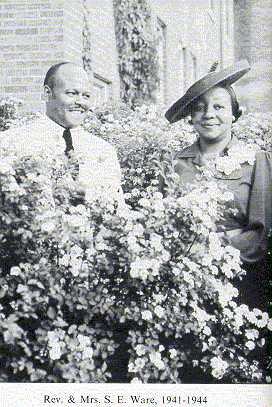
Rev. S. E. Ware succeeded Rev. Harris as pastor in 1941 and served until 1944. Rev. Ware came from Pittsburgh where he was on the ministerial staff of Central Baptist Church. He was a dynamic personality and during his tenure, the sanctuary and parsonage were remodeled. A new spirit of giving was created and many new members were added to the rolls.
Mrs. Ware was an accomplished musician who worked with the Senior Choir and singing group known as the Treble Clefs. An excellent teacher of voice, she contributed much toward the cultural enrichment of the community.
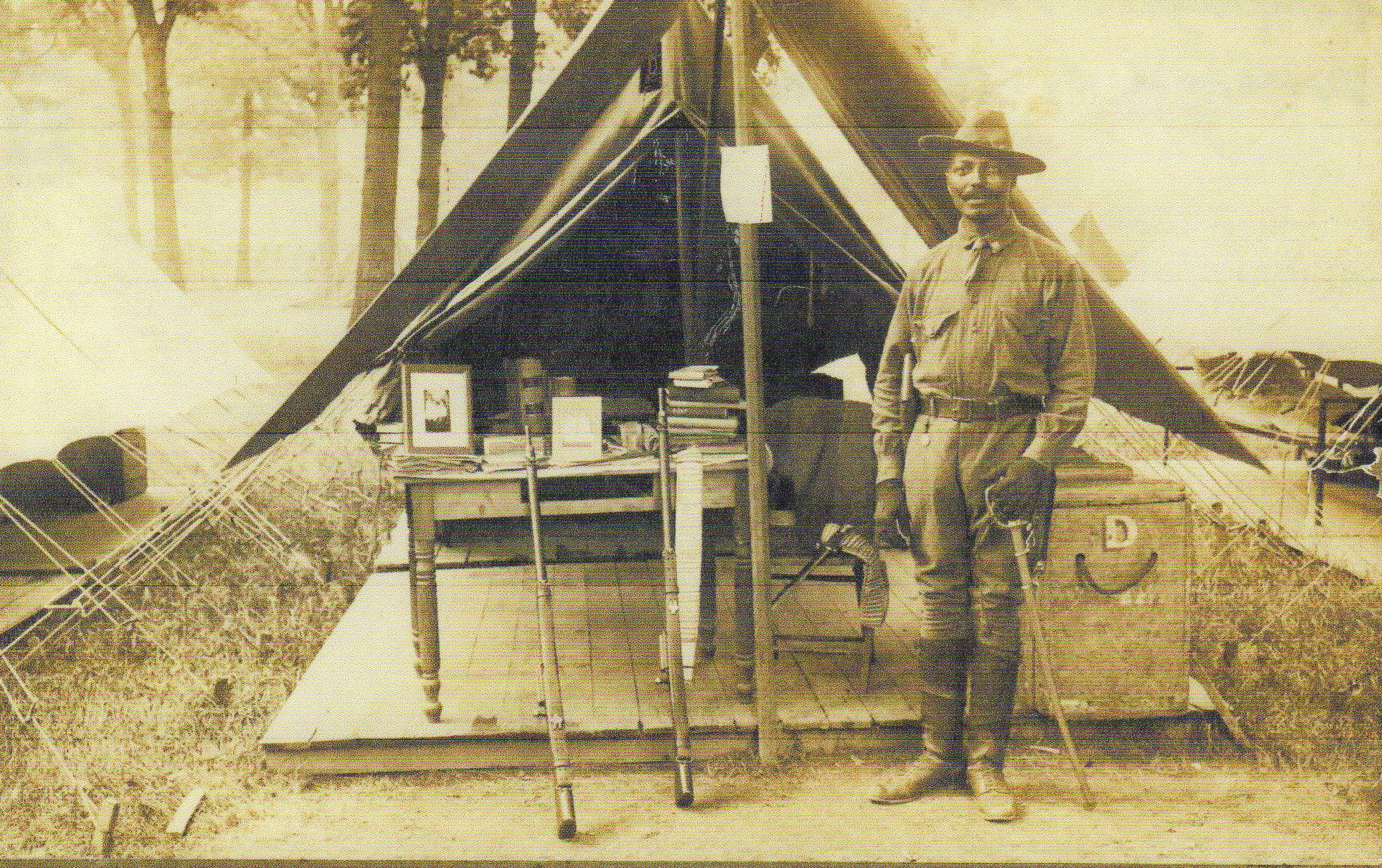
In September 1944, Floyd Massey, Jr., a graduate of Colgate-Rochester Theological Seminary and a native of North Carolina, began a long and illustrious ministry at Pilgrim. Immediately, the church roster was brought up to date and a budget system, through which an indebtedness of $5,000 was liquidated in eight months. Many improvements to the church were made. The roof and exterior walls of the sanctuary were repaired, the parsonage properly improved, and the Cedar Street church lots were saved by paying the taxes and later sold to the city for the Capitol Approach Project. Partitions were purchased to provide some privacy for church school classes, a public address system was installed and an electrical outdoor bulletin board presented. In addition, a cement sidewalk and curbing were built to improve the church yard.
A campaign to erect the Educational Unit began in 1946. From December 1948 to September 1949, the three story structure was built. It contains individual church school rooms for all departments, church office, pastor’s study, nursery, church parlour, baptismal dressing rooms, Board of Education office, lavatories, storage rooms, and a new gas furnace. Also in the same years, the Sanctuary, Fellowship Hall and the kitchen were completely redecorated. The kitchen was equipped to 300 people. In 1957 new pews were installed in the church and new hymnals purchased. In 1958 a new Wicks pipe organ was purchased and installed.
In May 1961, the congregation liquidated the indebtedness on the educational unit three years ahead of time. On October 8, 1961, the mortgage was burned on the $179,900 worth of improvements! The funds for this unusual feat were raised through the Fellowship Units System headed by the late Deacon Moses A. Knott, Sr.
Like Dr. Harris, Dr. Massey was also actively involved in national and community, religious and civic affairs. He served on the board of the Council of Churches, the Foreign Missions Board of both the National and the American Baptist Conventions, USA, Inc., among others. In 1962, Dr. Massey was elected President of the ABC Foreign Mission Societies. He also served on the Urban League board and was convener of the Rondo-St. Anthony Highway Organization, and chairman of the drive to rebuild Maxfield School. Reflecting his continuous interest in the educational system, Dr. Massey and members of Pilgrim spearheaded the drive to build a new Maxfield Elementary School.
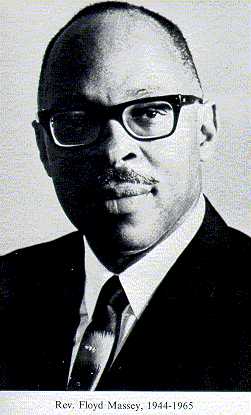
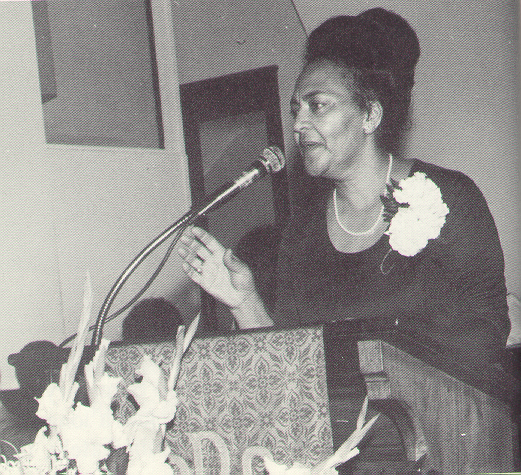
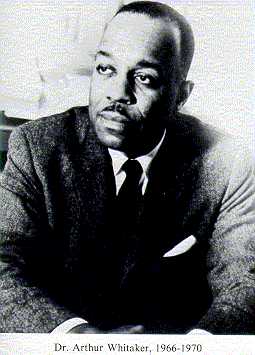
During his pastorate, Dr. Whitaker initiated a five year program for spiritual and physical renewal called “Operation, Transition, and Scope.” This program consisted of three stages: (1) a church-wide registration to determine the strength, participation, and potential of the membership; (2) an every-member canvas and percentage giving campaign to determine the actual active membership, and (3) to engage all members in underwriting the annual budget. Dr. Whitaker was also successful in establishing a unified current treasury – a practice consistent with American Baptist policy and practice.
Pilgrim also acquired more property under Dr. Whitaker’s leadership. A significant innovation for Pilgrim was the launching of Community Plaza. This is a 47 unit cluster of homes developed through the city’s Redevelopment Authority’s Urban Renewal program. Secondly, the church purchased a new parsonage at 1635 Virginia Street soon after Dr. Whitaker assumed the pastorate. He and his family, the former Virginia Aileen Carter, also a native of Boston, MA, and their four sons, Ronald, Mark, Paul, and Keith, moved into the new parsonage at 1635 Virginia Street on March 6, 1967.
Like his predecessors, Dr. Whitaker also participated in religious and civic affairs. While pastoring at Pilgrim, he lectured at Bethel College and Seminary and received the distinguished service award for services rendered as a member of the St. Paul Human and Civil Rights Commission. He was also elected president of the American Baptist Foreign Missionary Society.
Mrs. Whitaker, a graduate of the Wilson School in Boston, is a certified Laboratory Technologist. While here, she served as Vice-President of Christian Training for the American Baptist Women of Minnesota. She also directed a highly successful play, “After the Church Supper,” at Pilgrim.

Under Rev. Brown’s dynamic ministry, Pilgrim entered a new and glorious era. Highlights of his ministry include a substantial growth in membership, and expanded involvement of the Board of Education in the ministry of the youth. This program required a full time minister of social services, Rev. Dale Anderson. Rev. Brown instituted the 8:30 AM (now 7:45 AM) Sunday worship service. The library collection was organized, and the church newsletter, now called “Pilgrim’s Progress,” resumed publication.
Pilgrim’s financial growth and physical worth increased phenomenally under Rev. Brown’s leadership. With a $21,000 grant from I. A. O’Shaughnessy, the church purchased a bus and organized the Bus Ministry in May 1975 for program development. One of the most unique projects to be completed was the stained glass windows. These not only portray the church’s symbols, but also beautiful portraits of past ministers of Pilgrim and Dr. Martin Luther King III. The entire church, the sanctuary, Fellowship Hall, the parlour, and the Pastor’s Study was renovated. A Moeller organ, built in Hagerstown, MD, was installed. The total cost of these projects was $130,000. Later, the nursery and expanded session rooms were beautifully redecorated and furnished by the Young Women’s Guild.
Further, the Morris Plaza Housing Development was completed at the cost of $900,000. An electric chairlift for senior citizens and the handicapped was installed as was a new sound system. The church’s operating budget increased from $38,000 in 1969 to over $100,000.
Another significant development at Pilgrim was the initiating of a radio broadcast in 1972. This was a delayed broadcast of each Sunday’s 11:00 AM service. Rev. Brown encouraged an ecumenical ministry of involvement and organized groups, such as the New Horizon club for newly married couples and the Young Women’s Guild to provide another avenue of service. Also, Rev. Brown resurrected groups such as the Men of Courage Club and Young Adult and Youth Usher Board.
Following in what had become a tradition for Pilgrim’s pastors, Rev. Brown expended a lot of energy in religious and civic affairs. In the wider community, Rev. Brown served as a chairman of the board of the Community Housing Corporation, was a member of the St. Paul Planning Commission, President of the NAACP, and chairman of the Benjamin E. Mays Learning Center, a proposed alternative school for St. Paul.
Through his influence, Rev. Brown made Pilgrim, already a leader in civic and political affairs of the community, a haven for community forums and dialogue sessions on issues. Rev. Brown also served as president of the Minnesota State Baptist Convention, USA from 1971 to 1974 and served as a member of its national Board of Directors. He also served as chaplain for the Minnesota State Senate, a practice of Pilgrim’s pastors since 1916, taught at Sioux Falls College, and was a frequent lecturer at other area colleges.
On the national level, Rev. Brown’s energetic participation seemed boundless also. He served as National Chairman of the Black Caucus of the American Baptist Churches; Chairman of the Midwestern American Baptist Black Churchmen, National Co-Chairman of the Resolution Committee, and team leader for the ABC Evangelistic Life Style program. In 1974 Rev. Brown was selected as a delegate to the World Evangelism Congress in Switzerland, and in 1975 to the World Council of Churches in Nairobi, Kenya. Also in 1975 he attended St. James Academy for Parish Clergymen in Switzerland. In 1976 Rev. Brown was appointed to the national commission by the Urban League to study Black crime.
Rev. Brown was elected to Who’s Who in Black America in 1976 and was honored as Outstanding Young Man of America in 1972 and 1976.
Dr. Robert Louis Stephens is a native of North Carolina. Upon accepting God’s call to preach the gospel of Jesus Christ, Dr. Stephens aggressively pursued his educational training at Virginia Union Theological Seminary. After completing his educational training, Dr. Stephens trained and taught others entering into the ministry at Central Baptist Theological Seminary, Kansas City, MO as adjunct professor. Also while in Kansas City, Dr. Stephens founded the Peace Baptist Church. In January 1999, Dr. Robert L. Stephens became the 20th pastor of Pilgrim Baptist Church.
Under the pastoral leadership of Dr. Robert L. Stephens, Pilgrim Baptist Church was introduced to several relationship building tools to increase the congregation’s personal walk with our Lord and Savior, Jesus Christ. Dr. Stephens introduced several great process driven solutions to improve organizational effectiveness and develop effective leadership within the Church. Some of those opportunities include Experiencing God, The Purpose Driven Church, The Coming Church Revolution, The Joy of Discovery, The Joyner Report, Church Reconciliation Meetings, Church Wide Budgeting Process, and the Constitutional Review Committee.
Experiencing God and the Joy of Discovery were wonderful, personal spiritual development tools. Members were led to a heightened understanding of what God wanted to do within each of their lives. The Joy of Discovery provided invaluable tools to reading, interpreting, analyzing, and applying the Word of God into their daily lives.
The Purpose Driven Church and The Coming Church Revolution were wonderful church assessment and redefining tools. They provided the catalyst for positive organizational change and leadership development.
In November 2001, Dr. Stephens resigned as Senior Pastor of Pilgrim Baptist Church.
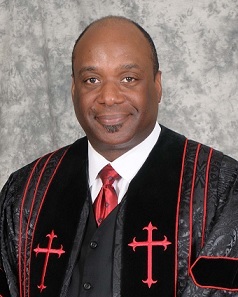
Reverend Gill matriculated at Nyack College in Nyack New York. Biblical Theological Seminary in Hatfield, Pennsylvania and Morehouse School of Religion at the Interdenominational Theological Center in Atlanta, Georgia where he received his B.A., M.A. and M.Div. respectively. May 2010, Drew University conferred upon Reverend Gill, the Doctor of Ministry where he specialized in the field of Worship, Spirituality and Preaching.
In March 2016 Dr. Gill was inducted into the Martin Luther King Board of Preachers at Morehouse College. August 1990, Reverend Gill was ordained into the ministry by the Reverend Saul S. Williams and the Hudson River Frontier Missionary Association at Universal Baptist Temple. During Reverend Gill’s Pastoral ministry, he served as Associate Minister of Zion Baptist Church in Ambler, Pennsylvania: Associate Minister of Antioch Baptist Church North, Atlanta, Georgia, and on the Pastoral Staff of the Concord Baptist Church of Christ, Brooklyn, New York. Since 2004, Reverend Gill has served as the Senior Pastor of Pilgrim Baptist Church, St. Paul Minnesota. During his administration, he is proud of the following accomplishments: the development of a strategic plan for ministry, the opportunity to participate and preside over several public action meetings. He is also proud that with the support of many people he was able to see the completed building / expansion project, the upgrading of the Pilgrim web site and the development of a web site ministry, the installation of a state of the art heating system, purchase of a new van and construction of a three bay garage.
Affiliated with the National Baptist Convention Reverend Gill served as Second Vice President of the State of Minnesota. He also serves the community in numerous denominational, civic and social endeavors i.e. (MABSSCO) Mid-American Baptist Social Service Corporation, St. Paul Area Council of Churches, ISAIAH, and President of the St. Paul Black Interdenominational Ministerial Alliance, etc. Yet his greatest joy is simply to serve his risen savior as an Ambassador, speaking boldly, making known the mystery of the gospel (Ephesians 6:19, 20)
Pilgrim celebrated its 150th Anniversary on October 28th.
Pilgrim's History in Long Form
Rev. Robert Thomas Hickman was a member of the group brought to St. Paul. He was born a slave in Boone County, Missouri. He worked as a rail-splitter, among other things, but his master taught him to read and gave him permission to preach to other slaves. Again, there is no doubt that Hickman arrived by boat, but other accounts had Hickman and followers aboard a raft adrift on the Mississippi. This raft was collected and towed upstream by a steamboat.
The new influx increased the population in this area, which forced city authorities to divide local Blacks into three groups. One group was sent to Southern Minnesota, another to Duluth and one remained in St. Paul. Shortly after this decision was made, Rev. Hickman and followers began to seek a place of worship. Calling themselves “Pilgrims.” Hickman’s prayer group held services in their homes in downtown St. Paul. Finally in November 1863, they succeeded in renting the lodge room of the God Temples in the Concert Hall Building on Third Street. After two months of planning and praying, Hickman and his followers were unable to incorporate a formal congregation without an ordained minister. Rev. Hickman sought and received mission status from the First Baptist Church of St. Paul in January 1864. Between 1864 and 1866 the Black parishioners continued to worship separately under Hickman’s direction. On November 15, 1866, Rev. Robert Hickman and others formally organized “PILGRIM BAPTIST CHURCH” in St. Paul, Minnesota. This act was celebrated by a baptismal service on the shores of the Mississippi River, climaxing three long years of frustration and hard work. The charter members of Pilgrim were Rev. and Mrs. Hickman, Fielding Combs, Henry Moffitt, John Trotter, Giles Crenshaw and members of their families.
This group petitioned the trustees of First Baptist to intercede and purchase in trust a lot costing $200.00 on which they would build a house of worship. The first church was built on this lot located on Sibley near Morris Street. The first Pilgrim Baptist Church was built with stone and wood, and had a seating capacity of 300. The building cost was $2400, including the lot. A portion of the white First Baptist Church of St. Anthony, Minneapolis, which was being razed, was given to our congregation to be used in the construction of the new church. The money to pay for removing the lumber was raised through an entertaining evening in Odeon Hall, chaired by D. E. Talbert. The first two ministers, William Norris (1866 – 1868) and Andrew Torbert (1868 – 1877) were white. The denominational leaders overlooked Robert Hickman, the leader and natural candidate for the position of minister. During this time, his role was an imposing one. He was clerk of the congregation and attended yearly denominational meetings. He was eventually licensed to preach in 1874 and ordained in 1875. When Hickman became the congregation’s official minister in 1878, the white ministry at Pilgrim ended.
Succeeding Rev. Hickman and serving from 1886-1887 was Rev. Bird J. Wilkins. During Rev. Wilkins’ pastorate, the first lot and church were exchanged for a second church lot which was built at Cedar Street and Summit Avenue. Things ran smoothly and uneventfully during the pastorates of the next five pastors.
